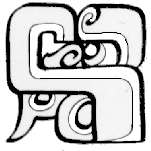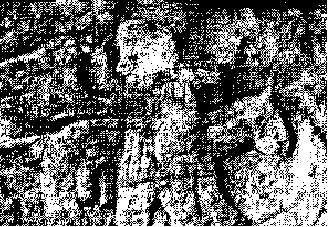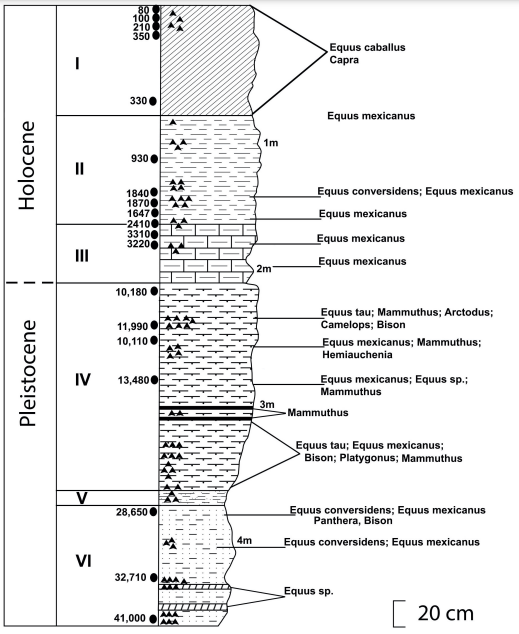Used in:
- I Nephi 5:216 [18:25]
- II Nephi 8:23 [12:7]
- II Nephi 8:98 [15:28]
- Enos 1:34 [1:21]
- Alma 12:76 [18:9]
- Alma 12:77 [18:10]
- Alma 12:79 [18:10]
- Alma 12:82 [18:12]
- Alma 12:188 [20:6]
- III Nephi 2:30 [3:22]
- III Nephi 2:44 [4:4]
- III Nephi 3:1 [6:1]
- III Nephi 9:101 [21:14]
- Ether 4:21 [9:19]
What does the Book of Mormon state?
- They existed in both Jaredite and Nephite times
At face value - Did horses exist in the New World?
Statement
- Both recorded evidence (glyph) and physical evidence (radiocarbon dated bones) indicate horses survived into the Nephite times (see evidence in the additional information section)
Assessment
- Horses were endemic to Mesoamerica and co-existed with man
Additional Material
- (Not Evidence) Early Hunters Period 13,000+/-? to 7,000+/- BC
- Maya Area: Northern Lowlands, Wild horses among prey
- (Suggestive) Remains of a horse have been reported found in conjunction with human remains in excavations at Loltun Cave in the Maya area. No date is apparent from the report.
- (Suggestive) Miami Museum of Maya Studies Newsletter 7, no. 11 (November 15, 1978):2.
- More positive is the evidence from Cenote Ch'en Mul, at Mayapan, Yucatan, reported by C.E. Ray. Two lots including horse bones were collected from the bottom stratum almost two meters down. Ray reluctantly concluded that they had to be pre-columbian ("pre-Columbian Horses from Yucatan," Journal of Mammology 38 (1957):278).
- (Suggestive) Horse bones in St. Petersburg, Florida dated to about 100 B.C
- Some question about contamination in the radiocarbon dating
- (Suggestive) T794 depicts a tapir and may be read as follows: simin, 'tapir/horse' and cak, 'lightning/rain'.
- Indicates that tapir and horse were treated the same
- Not sure if the "horse" context refers to Spanish horses

- (Evidence) A bearded man and a horse is carved on the Temple of Palques, Chichen Itza, Yucatan Mexico. It was photographed by Otto Done and appeared in The Improvement Era December 1955.

- (Evidence) Loltun Complex
- Two Mexican archaeologists carried out a project that included a complete survey of the complex system of subterranean cavities (made by underground water that had dissolved the subsurface limestone). They also did stratigraphic excavation in areas in the Loltun complex not previously visited. The pits they excavated revealed a sequence of 16 layers, which they numbered from the surface downward. Bones of extinct animals (including mammoth) appear in the lowest layers.
- Pottery and other cultural materials were found in levels VII and above. But in some of those artifact-bearing strata there were horse bones, even in level II. A radiocarbon date for the beginning of VII turned out to be around 1800 B.C. The pottery fragments above that would place some portions in the range of at least 900-400 B.C. and possibly later. The report on this work concludes with the observation that "something went on here that is still difficult to explain." Some archaeologists have suggested that the horse bones were stirred upward from lower to higher levels by the action of tunneling rodents, but they admit that this explanation is not easy to accept. The statement has also been made that paleontologists will not be pleased at the idea that horses survived to such a late date as to be involved with civilized or near-civilized people whose remains are seen in the ceramic-using levels.
- Peter J. Schmidt, "La entrada del hombre a la peninsula de Yucatan," in Origines del Hombre Americano, comp. Alba Gonzalez Jacome (Mexico: Secretaria de Educacion Publica, 1988), 250.
- (Evidence) Rancho Carabanchel, San Luis Potosi, Mexico
- Six specimens of Equus Mexicanus and one specimen of Equus conversidens were radio carbon dated between 3,220 BP (1198 BC) and 930 BP (1092 AD)
- Figure 3. Schematic section of sedimentary units at Rancho Carabanchel, Mexico. Solid black circles are radiocarbon samples (see Table 1 and text). Black triangles refer to location of Equus remains and radiocarbon dates as discussed in text. For simplicity of reading, Equus species designations leave out the notation 'cf.'




